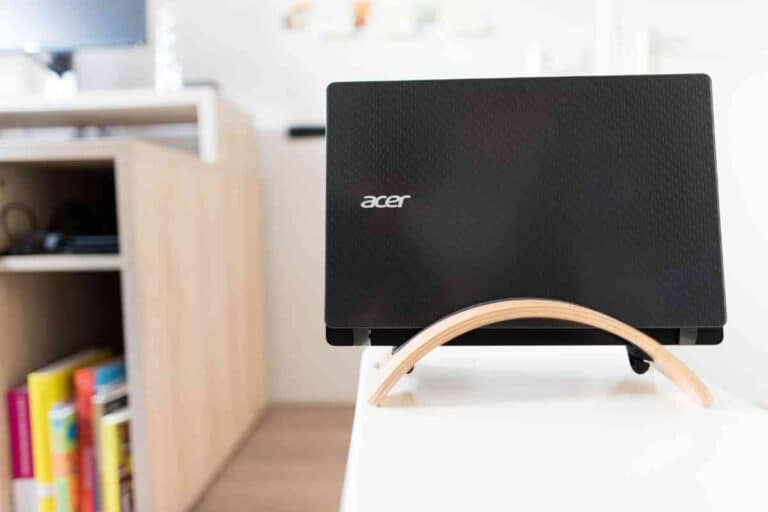Using MacBook Air in Small Businesses: A Compact Computing Solution
Choosing a MacBook Air

When we consider integrating MacBook Airs into our small business, it’s crucial to focus on the model’s suitability for our specific business needs and the criteria that guide our evaluation process.
MacBook Air Models for Small Business
The MacBook Air has been a favourite for its portability and power. In our experience, small businesses benefit from the latest models, which feature improved processors and battery life.
Currently, the MacBook Air models equipped with the M2 chip offer a compelling balance of performance and energy efficiency, making them a good fit for on-the-go professionals who require long battery life and capable processing power for everyday tasks.
| Model | Processor | RAM | Storage | Weight |
|---|---|---|---|---|
| M2 MacBook Air | 8-core CPU | 8GB | 256GB | 2.8 lbs |
| M2 MacBook Air | 8-core CPU | 16GB | 512GB | 2.8 lbs |
Note: We’re referring specifically to models pertinent to small businesses, keeping in mind the balance between specs and affordability.
Evaluation Criteria
Evaluating a MacBook Air for business use goes beyond just specs. We need to consider long-term value, compatibility with our business software, and the available support and warranty services.
When we recently outfitted our team with MacBook Airs, we first ensured that all our critical software was macOS compatible. We also compared service terms; Apple’s customer support was responsive, which reassured us when making the purchase.
- Performance Needs: Assess if an 8-core CPU and at least 8GB of RAM will suffice for your applications.
- Software Compatibility: Make certain your essential software runs smoothly on macOS.
- Support and Warranty: Consider Apple’s after-sale support, which can be crucial for maintaining productivity.
- Price and Budget: Determine whether the investment aligns with your budget for technology upgrades.
In short, choosing a MacBook Air for our small business required careful consideration of our current and future demands but resulted in a portable, powerful tool that aligned well with our workflow.
Setting Up Your MacBook Air

To ensure our small business runs smoothly, it’s crucial to properly set up our MacBook Air right from the get-go. We need to focus on the initial configuration, install essential business applications, and create user accounts that will set the foundation for our team’s daily operations.
Initial Configuration
Our first step is to lift the lid and power on the new MacBook Air. We’re greeted by the Setup Assistant, which takes us through the basics like connecting to Wi-Fi, signing in with or creating an Apple ID, and setting preferences for language and account.
It’s also the perfect time to set up Touch ID for quick, secure access. Settings can always be adjusted later by visiting System Preferences.
Installing Essential Business Apps
Once our MacBook Air is humming along, we dive into the Mac App Store to install the business apps we can’t do without. Whether it’s productivity suites like Microsoft Office or collaboration tools like Slack, it’s as simple as a search and a click.
For specialized tasks, we might need software from other sources, in which case, we allow apps from identified developers in the Security & Privacy settings.
And remember, keeping everything optimized is crucial – a clean, efficient MacBook Air means seamless business operations. Our own experience with CleanMyMac X proved it’s a boon for maintaining our fleet of Macs.
Setting Up User Accounts
Creating individual user accounts for our team members allows for personalized workspaces and keeps our data secure. On our MacBook Air, we head to Users & Groups in System Preferences and click the lock to make changes.
Here we add new users, assign them a role — such as administrator or standard user — and with the help of parental controls, restrict access if necessary. Keeping track of who has admin rights is essential; we’ve learned that oversight can prevent a whole host of security issues.
By carefully following these steps, our business is all set to leverage the power and simplicity of the MacBook Air from the first day.
Optimizing Productivity

In our journey with the MacBook Air, we’ve found that its features are not just about sleek design or power. It’s about how we can harness these features to enhance our productivity in small business environments.
Time Management Tools
MacOS offers a variety of time management tools that can help us stay on track with our tasks. For instance, the Calendar app synchronizes across all Apple devices, ensuring we never miss an appointment. Moreover, Reminders provide us with timely alerts for our to-dos.
| Time Management Tool | Description |
|---|---|
| Calendar | Syncs events and appointments across all devices. |
| Reminders | Sets alerts for to-dos and important tasks. |
| Clock | Keeps us aware of the time with alarms and timers. |
We remember how integrating these tools into our daily operations significantly improved our time management capabilities.
Collaboration and Communication Software
Our MacBook Air shines in facilitating collaboration and communication. Tools like FaceTime and Messages integrate seamlessly into our workflow, enabling instant connections with colleagues and clients.
Additionally, the continuity features of macOS allow us to hand off documents from a MacBook to an iPhone or iPad with ease, keeping everyone on the same page.
File Organization Techniques
Effective file organization is pivotal for productivity. Finder on the MacBook Air allows us to customize views and access tags swiftly for enhanced file management.
Using Smart Folders, which automatically group files based on criteria we set, saves us significant time we used to spend on manual sorting.
| File Organization Technique | Description |
|---|---|
| Tags | Instantly categorize and find files. |
| Smart Folders | Auto-group files based on custom criteria. |
| iCloud Drive | Access files across devices and share with team members. |
When we first shifted to a Smart Folders system, we were astonished by the simplicity and time saved searching for documents.
Security and Maintenance
In our years of exploring the latest tech, we’ve found that maintaining the integrity and performance of our devices is key, especially when it comes to small business operations where resources are often limited.
Data Protection Strategies
When it comes to safeguarding our MacBooks, data protection is a priority. We rely on FileVault to encrypt our entire system which ensures that our files and documents remain secure.
Additionally, enabling firewall settings and using antivirus software are steps we never skip. For small businesses, setting up a VPN is also crucial for protecting sensitive data when working on public networks.
Our strategy includes:
- Enabling FileVault for encryption
- Utilizing built-in firewalls
- Regular antivirus scans
- Using VPNs for secure remote access
Regular Maintenance Schedule
Establishing a regular maintenance schedule preserves our MacBook Airs’ efficiency and longevity. We weekly run Disk Utility to check for disk errors and perform a system cleanup using tools like CleanMyMac. We also ensure our software is up to date with the latest security patches.
Weekly tasks:
| Task | Purpose |
|---|---|
| Disk Utility checks | To fix disk errors |
| System cleanup | To remove unnecessary files |
| Software updates | To patch security vulnerabilities |
Remember, consistent updates and cleanups keep our business running without hiccups.
Bold personal anecdote: In our experience, sticking to a consistent schedule saved one of our MacBooks from a potentially costly hard drive failure. Regular checks caught the issue before it escalated.
MacBook Air Mobility
The MacBook Air affords users unparalleled convenience and efficiency when on the move. Its lightweight design and prolonged battery life make it an essential tool for professionals navigating the demands of travel and remote work.
Accessories for Travel
When preparing for travel, we’ve found the right accessories can transform the MacBook Air from a mere notebook to an all-in-one mobile workstation. Here is what we recommend carrying along:
- Portable Charger: A high-capacity USB-C power bank ensures that we can recharge our MacBook Air even when an outlet isn’t nearby.
- Travel Adapter: We always keep a universal travel adapter in our bags for seamless connections anywhere.
Table: Must-Have MacBook Air Travel Accessories
| Accessory Type | Product Recommendations | Why It’s Essential |
|---|---|---|
| Portable Charger | Anker PowerCore+ or similar brands | Keeps MacBook Air charged on-the-go |
| Travel Adapter | Skross World Adapter or equivalent | Provides power connectivity worldwide |
Remote Work Solutions
As for working remotely, the MacBook Air’s versatility shines through with its simple yet powerful features. Through our experience, these elements are game-changers for remote work:
- Cloud Storage Services: Applications like iCloud or Dropbox are crucial. They allow us to access files from anywhere, keeping us connected to our work.
- Video Conferencing Tools: Facetime and Zoom work seamlessly, providing reliable video communication options.
Our personal experience has shown the importance of a nimble setup:
On a trip last year, our MacBook Air proved to be an anchor as we navigated multiple client projects from a bustling airport lounge. The ease of flipping it open to join a last-minute video call or to fire off urgent emails was a testament to its design as the mobile professional’s lifeline.
Troubleshooting Common Issues
In our journey with MacBook Airs in small business settings, we’ve come to understand that efficiency hinges on smooth operations. Here, we’ll share fixes to some hardware and software issues that could hinder your productivity.
Hardware Problems and Solutions
Problem: MacBook Air not turning on
Solution: Check the power supply and ensure the charger is connected properly. If the issue persists, try resetting the System Management Controller (SMC) by following the procedure recommended by Apple.
Problem: Unresponsive keyboard or trackpad
Solution: Restart your MacBook Air. If the problem continues, check for updates as it could be a software issue affecting the hardware’s responsiveness. External factors such as dust or debris might also cause this issue, so cleaning the keyboard or trackpad might help.
Here’s a useful table summarizing the hardware troubleshooting steps:
| Issue | Step 1 | Step 2 | Step 3 |
|---|---|---|---|
| Won’t Power On | Check Charger | Reset SMC | Seek Professional Help |
| Keyboard/Trackpad Unresponsive | Restart Mac | Update Software | Clean Hardware |
Once, my own MacBook Air’s keyboard started acting up right before a presentation. A quick restart fixed the issue, saving us from what could have been an embarrassing situation.
Software Glitches and Fixes
Problem: MacBook Air running slow
Solution: Check your storage because if your hard drive is nearly full, it could slow down your system. Consider offloading some files or using cloud storage solutions.
Problem: Applications not responding
Solution: Force quit the app by pressing Command + Option + Esc and select the unresponsive application. If a particular app frequently crashes, look for software updates or an alternative app that’s more reliable.
Troubleshooting software can be as straightforward as:
- Ensuring your macOS is up to date
- Running Disk Utility to check for disk errors
- Removing unnecessary login items that slow down startup times
We once encountered a software update that wouldn’t install, causing several apps to behave oddly. Turns out, a simple safe mode start allowed us to complete the update and restore normal function.
Upgrading Your MacBook Air
Keeping our MacBook Air up-to-date ensures we benefit from the latest technology and maintain efficiency in our small business operations. It’s both about optimal performance and getting value from our investment.
When to Upgrade
We typically consider upgrading our MacBook Airs when they no longer support the latest operating system or when performance issues start affecting our productivity. Hardware advances, such as those seen with the introduction of Apple’s M1 chip, offer significant improvements in speed and battery life, which can enhance our workflows.
From personal experience, I recall the switch from an older Intel-based MacBook Air to the M1 model. It was like night and day, especially when it came to battery life and the ability to handle multiple applications smoothly.
Resale and Recycling Options
When we decide to upgrade, we also think about the responsible disposal of our old devices. Apple provides recycling programs that are convenient and environmentally friendly. Moreover, MacBook Airs hold their value well, and we can often recoup a portion of our investment by selling our used models.
| Option | Description | Benefit to Small Business |
|---|---|---|
| Trade-In | Apple’s Trade-In program offers credit toward new purchases. | Reduces the cost of the upgrade. |
| Third-Party Resellers | Various platforms where equipment can be sold. | Potentially higher resale value. |
| Recycling | Apple’s recycling program ensures devices are disposed of responsibly. | Aligns with our environmental commitments. |
Selling our old MacBook Airs has sometimes helped fund the new purchases, making the upgrade process more affordable. We once sold a batch of our outgoing MacBooks swiftly online, which was surprisingly efficient and financially beneficial.
Cost Analysis
When we look at integrating MacBook Airs into our small business operations, we need to consider the full financial implications. Specifically, we’ll examine the total cost of ownership and the potential return on investment to understand the economic value of these devices.
Total Cost of Ownership
The total cost of ownership (TCO) for MacBook Air includes the purchase price, any add-ons or upgrades, maintenance fees, and technical support over the device’s lifespan. Typically, we find that a MacBook Air starts around $999, but the cost can rise to $2,249 with additional features.
| Cost Item | Initial Cost | 3-Year Cost (Estimated) |
|---|---|---|
| Base Model MacBook Air | $999 | $999 |
| Upgrades & Add-ons | Up to $1,250 | Up to $1,250 |
| Maintenance & Support | $0 (included with AppleCare) | ~$300 |
| Total | Up to $2,249 | Up to $1,250 |
Our company’s past experience revealed that Apple’s robust ecosystem led to minimal downtime due to technical issues. The integrated nature of macOS and fewer virus susceptibility kept our support costs lower than anticipated.
Return on Investment
While the TCO provides us with an idea of the spending, Return on Investment (ROI) gives us the potential value. Investment in MacBook Airs often increases productivity given their reliability and ease of use, and according to studies, businesses have seen cost savings from reduced IT support costs totaling $12.4 million over three years.
| Outcome | Benefit Amount |
|---|---|
| Reduced IT Support Costs | $12.4 million (for large samples) |
| Increased Productivity | Variable |
We personally found that the MacBook Air’s extended battery life meant our teams could work longer without seeking a power outlet, keeping them focused on tasks at hand. This type of indirect benefit is difficult to quantify but is undoubtedly a positive contributor to ROI.
In conclusion, examining both the TCO and ROI of MacBook Airs can provide us with a clearer financial picture, ensuring we make informed decisions that will benefit the business in the long run.
More Macbook Air Articles: (Read These Next)
- Best MacBook Air Models
- MacBook Air Buying Guide
- Setting Up Your New MacBook Air
- MacBook Air Storage Options
- MacBook Air for Students
- MacBook Air vs MacBook Pro
- Enhancing MacBook Air Performance
- Top MacBook Air Accessories
- Solving Common MacBook Air Problems
- MacBook Air for Writers
- Latest macOS Features for MacBook Air
- MacBook Air for Remote Work
- Buying a Refurbished MacBook Air
- MacBook Air Keyboard Shortcuts
- MacBook Air for Travel
- Securing Your MacBook Air
- MacBook Air and the Apple Ecosystem
- MacBook Air Screen Features
- Personalizing Your MacBook Air
- MacBook Air for Content Creation
- Transitioning to MacBook Air from PC
- MacBook Air for College
- Light Gaming on MacBook Air
- Extending MacBook Air Battery Life
- MacBook Air Connectivity and Ports
- Using MacBook Air in Small Businesses
- Reviewing the MacBook Air with M1 Chip
- MacBook Air vs Windows Ultrabooks
- Sustainable Use of MacBook Air
- Anticipating Future MacBook Air Developments






